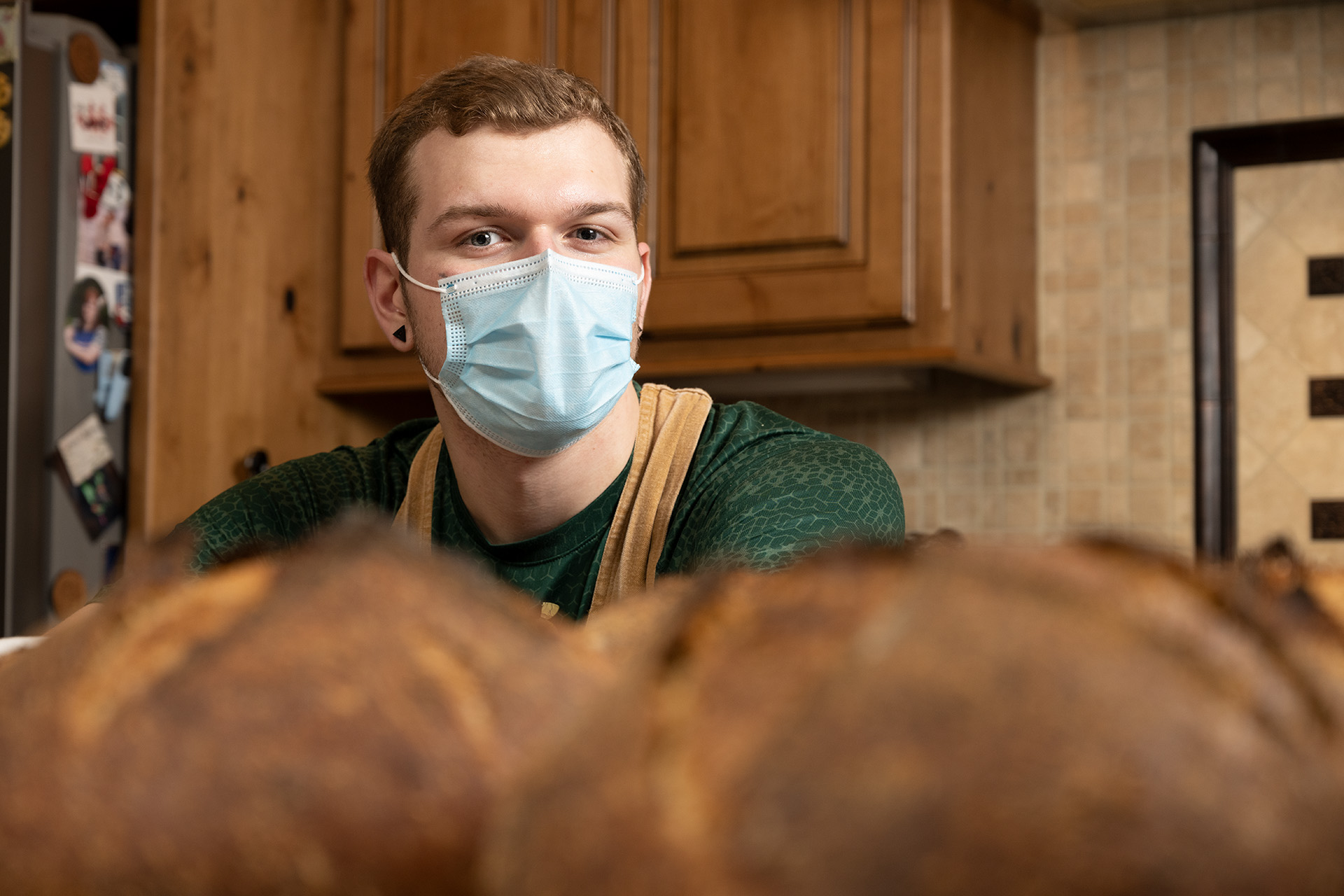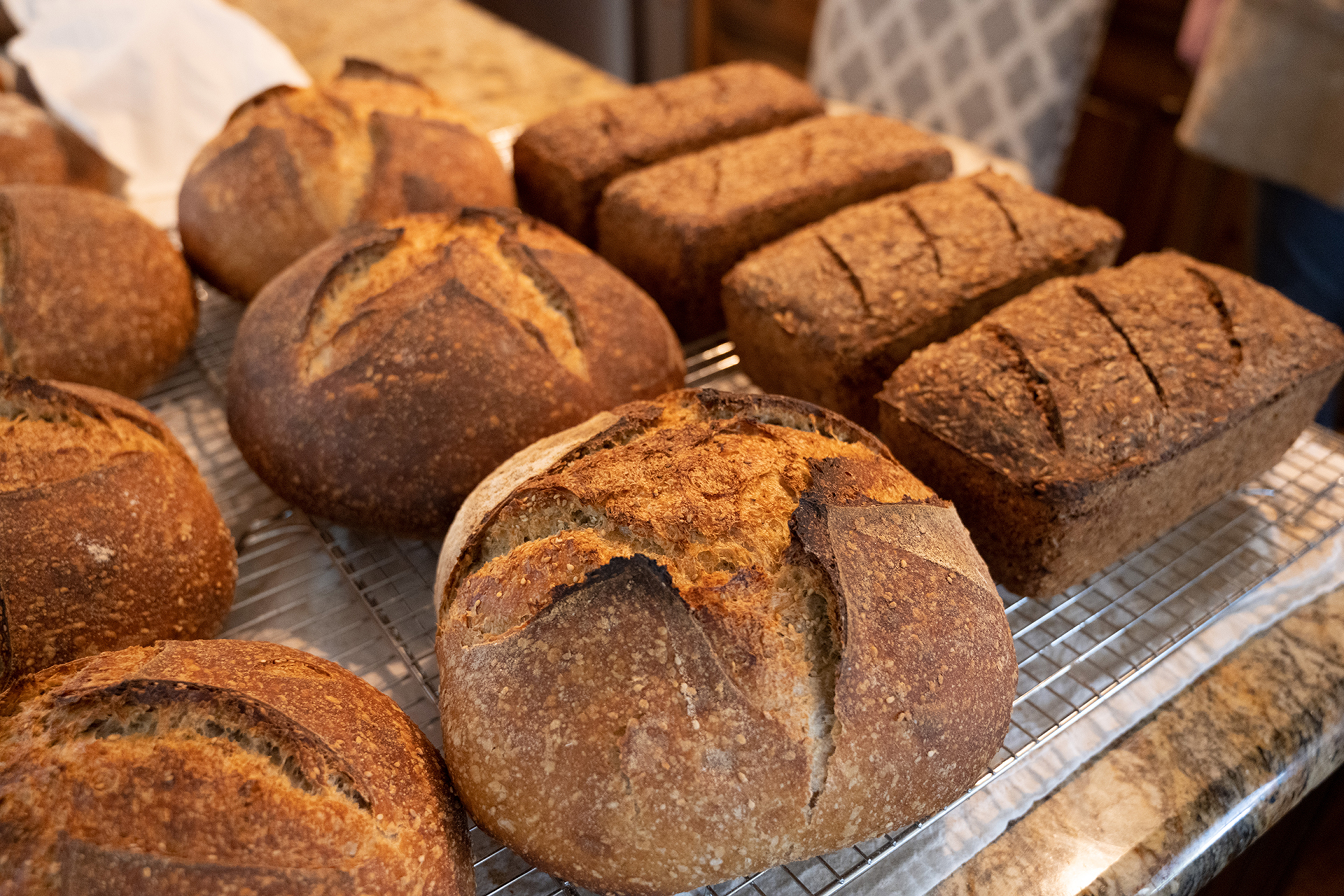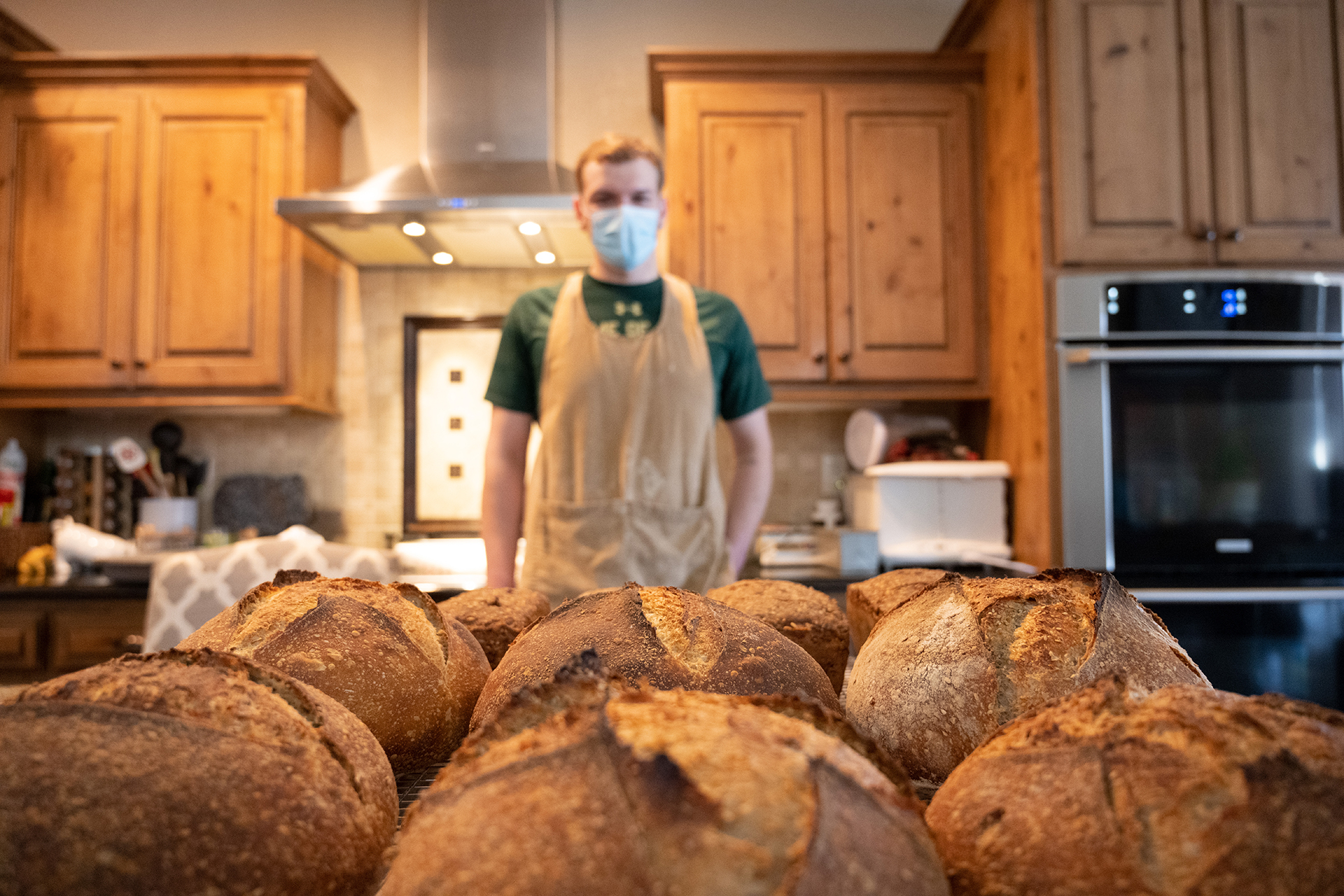
Noah Bowman, owner of Chubby Cat Bakery, is a junior health and exercise science major who started baking during the COVID-19 quarantine. Photo by John Eisele/CSU Photography
When Colorado put stay-at-home orders in place to help stop the spread of the virus that causes COVID-19 last March, many shut-ins tried their hand at making sourdough bread. Noah Bowman, a Colorado State University undergraduate student, grew his sourdough hobby into a business, The Chubby Cat Bakery.
“In December 2019, I had no idea about sourdough bread,” said Bowman, a Health and Exercise Science major. “Over quarantine, I moved back with my family. I had a lot of people that I could feed, so was just baking a lot – got a lot of practice in. I just kind of fell in love with it and the ball’s been rolling ever since.”
“About July, I was like, ‘Can I sell this? Is that possible?’ I looked into it a little bit, and by the end of the month I had my business registered,” he explained.
Colorado is one of a number of states that allows certain edible products made at home to be sold directly to the public without the use of a commercial kitchen, under the Cottage Foods Act.
The Chubby Cat Bakery sells baked-to-order bread and other sourdough items each week. Customers order online by Thursday and pick up on Saturday. Bowman also delivers in Fort Collins.
Bowman makes about 30-35 loaves each week. He mixes everything by hand (and says his forearms get pretty tired by the end of it) and spends every Friday baking at his parents’ house.
“The oven’s on all day. My mom’s complaining that it’s too hot in the house,” he said.
Next year he’s moving into a place with a second kitchen in the basement, which he’s already calling the “bread lair.”
“I’ve been selling out consistently for the past few months now. To have a good business, you need a lot of repeat customers, and that’s been one of the hallmarks of my business,” said Bowman. “I’m really thankful for them.”
To understand why Bowman bakes just once a week, we have to look at the microbes that put the sour in sourdough.
Hard-working microbes

Sourdough bread has a natural “starter,” a diverse culture of yeast and bacteria used to ferment carbohydrates and proteins in flour. Photo by John Eisele/CSU Photography
Over the last year, we’ve learned a lot about living things we can’t see, a.k.a. microbes. Some of them are harmful (like SARS-CoV-2 or Salmonella), but there are good microbes (like those that ferment foods), too.
Instead of commercial yeast that makes the dough rise quickly, sourdough bread is made with a natural “starter,” a diverse culture of yeast and bacteria used to ferment carbohydrates and proteins in flour. Bread makers feed the starter flour and water and care for it like a pet you can put in the fridge every so often.
“Sourdough is a contribution of both bacteria and yeast,” explained Caitlin Clark, a graduate student in the Food Science and Human Nutrition department with experience in fermentation science. [The microbes] might be on the hands or tools to mix the sourdough, but a lot of it is also contributed by the flour.”
“People think you don’t eat raw cookie dough because of the eggs. It’s actually because of the flour,” said John Wilson, also a FSHN graduate student. “Because [the wheat] is out in the field, right? It’s processed and it’s not treated.”
Wheat is harvested and dried before being ground into flour. Microbes get incorporated into the flour in these processes. Most of them are harmless or even beneficial, but sometimes they can be pathogenic. Regardless of the type of microbe, they don’t grow in the flour because it’s too dry.
“Flour is around 2% or 3% moisture and that’s not high enough for those organisms to be active – they’re still present, they’ll just be dormant. But when water is added, those organisms become active,” Clark explained.
This is where the art of culturing a starter comes in – fermentation (unlike rot or “putrefaction”) is a controlled process that encourages beneficial microbes to grow while discouraging pathogenic ones.
The art of the culture
Bowman feeds his starter on Wednesday night. On Thursday, he makes the bread by mixing the starter into even more flour and water. The yeast start off by eating simple carbohydrates in the flour and burp out carbon dioxide, which makes air pockets, rising the dough.
As brewers can attest, yeast do more than burp CO2. They produce alcohol, too. But sourdough is not “alcohol-dough” – this is where the bacteria come in. Certain types of bacteria slurp up the alcohol made by the yeast and turn it into acid, like vinegar, making the dough sour.
“Essentially they have a symbiotic relationship where the outputs of the yeast metabolism can be used by the bacterial metabolism,” said Clark.
The bacteria secrete enzymes that help break down proteins like gluten, which the bacteria and yeast can absorb and use to grow.
“You have organisms that don’t take whole particles of food in. They put it through a digestion process externally,” said Wilson.
After letting the dough rise, Bowman puts it in the fridge overnight. This gives the bacteria time to eat and then secrete compounds (mostly acids) that make the bread more flavorful – and act as a preservative. The acid in the bread inhibits other things from growing on it once it’s baked.
“By putting it in [the fridge] overnight, you don’t just get a tastier loaf, you also get a loaf that will last longer,” said Bowman. “The bacteria do all the work. The yeast gets all the credit.”
Today, most store-bought breads are made in a few hours from a purified culture of yeast. Even some commercially produced “sourdoughs” are not actually fermented – to save time, producers add acids to the dough to impart flavor without going through the lengthy fermentation.
Fermentation is a process essential to creating a variety of foods, from kimchi to cheese and of course beer. Bowman plans to take classes offered for CSU’s degree in Fermentation Science and Technology, so he can learn more about the chemistry of fermentation.
Start(er)ing a business

Bowman’s Chubby Cat Bakery sells baked-to-order bread and other sourdough items each week. Photo by John Eisele/CSU Photography
There’s a certain magic to fermented foods. Like Frankenstein’s monster, they seem to come to life from what appear as inanimate substances. Businesses sometimes have a similar characteristic, and, like the relationship between bacteria and yeast in sourdough, there is an entire ecosystem that makes them rise.
Bowman is running his bakery according to the regulations of the Cottage Food Act, which requires food safety training developed by CSU Extension. The Extension service also offers food processing support services and an Ask an Expert resource, as well as consultations on taking a product to market and information on healthy nutrition and processing food at home through Food Smart Colorado.
Fort Collins also has great resources for buying bulk foods, like the Shamrock Food Service Warehouse, which is open to the public and doesn’t require a membership.
“It’s basically a small Sam’s Club for chefs,” said Bowman. “Anybody can shop there – it’s awesome.”
And the name, The Chubby Cat Bakery? Bowman’s cat, Eva, who, when curled up in a ball, is about the size of a loaf of sourdough bread.
“My cat, she loves my bread. I don’t try to feed it to her, but if there are crumbs on the ground, I always have to stop her from eating it,” said Bowman.